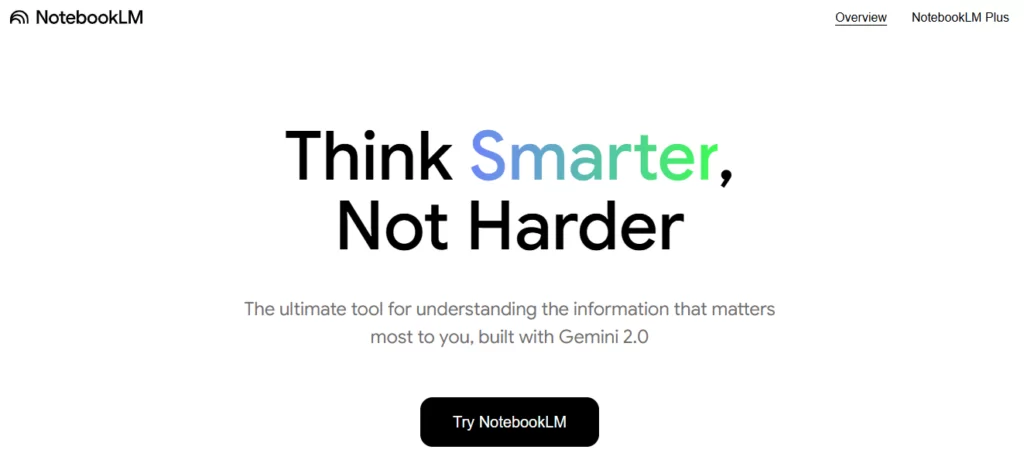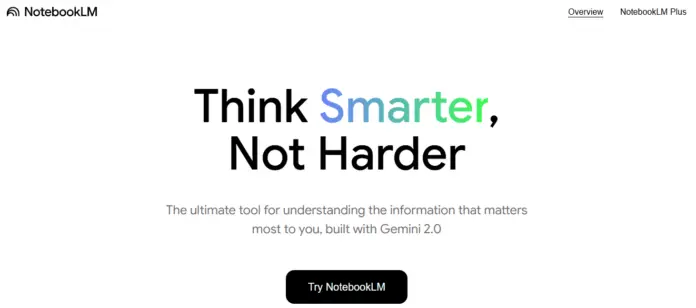As a PhD scholar with over a decade of experience in research, I’ve sifted through countless papers, constructed literature reviews from scratch, and spent long hours organizing my findings. Despite the experience, managing vast amounts of information remains a challenge. That’s why discovering Google’s NotebookLM felt like a game-changer. NotebookLM for Academic Research is not just another note-taking app—it’s an AI-powered assistant that helps researchers streamline their academic workflows. I’ve used it extensively, and here’s my honest take on how it’s reshaping the way I conduct and manage my research.
What is NotebookLM? My Experience Using It for Academic Research
NotebookLM is essentially an intelligent notebook designed to work with the documents you upload. It doesn’t just store them—it understands them.
With NotebookLM, I can:
- Upload research articles, notes, and files
- Receive AI-generated summaries and key points
- Ask contextual questions and get responses grounded in my documents
- Track and verify citations within those documents
It’s a lot like having a research assistant who’s read everything I have—and remembers it all.
Extending My Research Capabilities with AI
Here’s how NotebookLM fits into my research workflow:
Literature Synthesis in Minutes
Instead of spending hours combing through articles, I upload my reading list into NotebookLM and quickly get concise summaries. It’s perfect for forming an initial understanding when diving into a new research area.
🔗 Connecting the Dots Across Sources
One of the most impressive features is how the AI reveals hidden connections between documents. It often highlights links I hadn’t considered, helping me think more holistically about the research questions I’m exploring.
📚 Smarter Citation Support
As I write, NotebookLM suggests references from my uploaded sources—contextually relevant and easy to verify. This alone has significantly improved the way I build literature-backed arguments in my writing.
Getting Started Was Easy
Here’s how I began:
- Logged in at https://notebooklm.google with my Google account
- Created a new notebook workspace
- Uploaded PDFs and notes from my drive
- Let the AI generate summaries and suggest questions

From there, I started interacting with my content—asking questions, finding insights, and even comparing methodologies across papers.
My Favorite Feature: Chatting with My Documents
The chat-based interface isn’t a generic chatbot—it only uses the sources I upload. So when I ask specific research questions, the AI responds with grounded, reference-linked answers.
And the in-line citations? Game-changing. I can trace every answer directly to the source material, speeding up my validation process.
A New Way to Learn: Audio Overviews
NotebookLM also offers audio overviews, where AI hosts turn my documents into podcast-like conversations. I found this incredibly helpful when I wanted to absorb material passively—say during a walk or while prepping notes.
It’s a great complement to deep reading, especially when revisiting older sources.
Security, Privacy, and Responsible Use
I take research integrity seriously, so privacy matters. Google makes it clear that uploaded content is not used to train the model, and everything stays private unless you choose to share it.
Still, I recommend always reviewing current privacy policies and being mindful when uploading unpublished or sensitive materials.
Limitations (And How I Work Around Them)
NotebookLM is still evolving. Occasionally, citation links point to unexpected sections, and it may miss subtle technical details. That’s why I always cross-verify before using information in formal publications.
In short, I treat NotebookLM as a supportive tool, not a replacement for my own judgment or critical analysis.
Transforming the Way I Do Literature Reviews | NotebookLM for Academic Research
This tool has completely changed how I approach literature reviews. I can now:
- Synthesise information from multiple sources
- Ask questions that draw from my entire research library
- Compare theoretical frameworks or experimental methods with ease
NotebookLM helps me identify research gaps faster, build strong narratives, and avoid redundancy—all while saving hours.
Frequently Asked Questions about Google’s NotebookLM
1. What is Google’s NotebookLM and what are its primary functions for academic researchers?
NotebookLM is an experimental AI-powered notebook developed by Google designed to enhance the analysis and understanding of academic literature and other textual documents. Its primary functions include intelligent document analysis, automatic content summarization, interactive querying of uploaded sources with in-line citations, and the generation of various research aids such as FAQs, study guides, tables of contents, timelines, and briefing documents. It acts as a “tireless research assistant” by efficiently processing and synthesizing information from multiple sources.
2. How does NotebookLM differ from general-purpose AI chatbots like ChatGPT or Claude in the context of academic research?
Unlike general-purpose AI chatbots that draw from a vast, generalized knowledge base, NotebookLM operates solely on the documents uploaded by the user. This “source-grounded” approach ensures that all responses and generated content are directly derived from the provided materials, complete with in-line citations that link back to the specific locations within the source documents. This focused interaction enhances relevance, accuracy, and the traceability of information, making it particularly valuable for literature reviews and in-depth research tasks where grounding in specific texts is crucial.
3. What are the key steps involved in using NotebookLM for academic research?
Getting started with NotebookLM involves several straightforward steps: accessing the platform using a Google account, creating a new notebook, and then adding content. Content can be uploaded from Google Drive, as PDF or text files, via copied text, webpage URLs, or Markdown files. Once uploaded, NotebookLM performs an initial analysis, providing summaries and suggesting potential questions. Users can then interact with their sources through a chat interface, ask targeted questions, and customize which sources the AI draws upon for its responses. NotebookLM also offers features to generate various research aids from the uploaded documents.
4. How can NotebookLM specifically aid in conducting literature reviews, as highlighted in the sources?
NotebookLM offers several features that significantly streamline the literature review process. The “chat” function allows users to pose questions that span multiple uploaded papers, enabling efficient multi-source synthesis and the exploration of specific themes or concepts across various texts simultaneously. The AI provides synthesized answers with in-line citations, making it easy to trace information back to its origin. Furthermore, NotebookLM can help identify common themes, contradictions, research gaps, and compare theoretical frameworks or methodologies across different studies, all through conversational interaction with the uploaded literature.
5. What considerations regarding data security, privacy, and ethical use should researchers keep in mind when using NotebookLM?
While Google states that user data uploaded to NotebookLM is not used for training the AI model and that privacy is preserved, researchers must still exercise caution. It’s essential to ensure that the use of NotebookLM aligns with university data handling policies and ethical review board commitments, especially when dealing with sensitive research materials. Researchers should be mindful of the platform’s terms of service, which can change, and always prioritize the security and privacy of their data, consulting with institutional data protection officers or ethics committees if in doubt.
6. What are the limitations or “catches” associated with using NotebookLM as an experimental AI tool for research?
As an experimental tool, NotebookLM has certain limitations. For large documents like theses, it might occasionally miss information due to token limits. The accuracy of in-line citations can sometimes be inconsistent, requiring users to double-check the referenced locations. Additionally, uploaded documents do not include images. The AI-generated audio overview feature, while innovative, can sometimes contain minor inaccuracies in technical details. Users should approach NotebookLM as a complement to, rather than a replacement for, critical thinking and traditional research methods, always verifying information and maintaining a balanced perspective.
7. Beyond text analysis, what other notable features does NotebookLM offer, such as the audio overview capability?
NotebookLM has introduced an “Audio Overview” feature that can transform uploaded documents into conversational podcast episodes featuring AI-generated hosts. This allows users to engage with their research materials in an auditory format, which can be beneficial for accessibility, multitasking, and understanding key concepts more engagingly. While still experimental and potentially containing minor inaccuracies, this feature offers a novel way to interact with and disseminate research insights.
8. How can researchers further develop their AI literacy skills and stay updated on the advancements in AI tools for academia, as suggested by one of the sources?
Researchers can further develop their AI literacy by seeking out resources such as books (e.g., ‘AI-Powered Scholar’), blogs, and newsletters that focus on AI and its applications in higher education. These resources can guide building AI literacy skills, understanding the history of AI development, and learning about new tools and techniques for academic writing and research. Staying informed about the latest advancements and engaging with educational content can help researchers effectively integrate AI tools like NotebookLM into their workflows while maintaining a critical and informed perspective.

